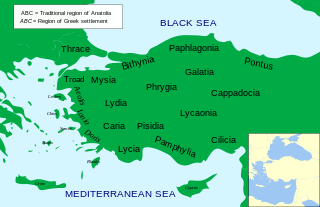Related Research Articles
This article concerns the period 159 BC – 150 BC.

This article concerns the period 329 BC – 320 BC.
This article concerns the period 269 BC – 260 BC.
This article concerns the period 179 BC – 170 BC.
This article concerns the period 189 BC – 180 BC.
This article concerns the period 199 BC – 190 BC.
Year 150 BC was a year of the pre-Julian Roman calendar. At the time it was known as the Year of the Consulship of Flamininus and Balbus. The denomination 150 BC for this year has been used since the early medieval period, when the Anno Domini calendar era became the prevalent method in Europe for naming years.
Year 196 BC was a year of the pre-Julian Roman calendar. At the time it was known as the Year of the Consulship of Purpureo and Marcellus. The denomination 196 BC for this year has been used since the early medieval period, when the Anno Domini calendar era became the prevalent method in Europe for naming years.
Year 179 BC was a year of the pre-Julian Roman calendar. At the time it was known as the Year of the Consulship of Flaccus and Fulvianus. The denomination 179 BC for this year has been used since the early medieval period, when the Anno Domini calendar era became the prevalent method in Europe for naming years.
Year 321 BC was a year of the pre-Julian Roman calendar. At the time, it was known as the Year of the Consulship of Calvinus and Caudinus. The denomination 321 BC for this year has been used since the early medieval period, when the Anno Domini calendar era became the prevalent method in Europe for naming years.
Year 320 BC was a year of the pre-Julian Roman calendar. At the time, it was known as the Year of the Consulship of Cursor and Philo. The denomination 320 BC for this year has been used since the early medieval period, when the Anno Domini calendar era became the prevalent method in Europe for naming years.

The Kingdom of Pergamon, Pergamene Kingdom, or Attalid kingdom was a Greek state during the Hellenistic period that ruled much of the Western part of Asia Minor from its capital city of Pergamon. It was ruled by the Attalid dynasty.

Pharnaces II of Pontus was the king of the Bosporan Kingdom and Kingdom of Pontus until his death. He was a monarch of Persian and Greek ancestry. He was the youngest child born to King Mithridates VI of Pontus from his first wife, his sister Queen Laodice. He was born and raised in the Kingdom of Pontus and was the namesake of his late double great grandfather Pharnaces I of Pontus. After his father was defeated by the Romans in the Third Mithridatic War and died in 63 BC, the Romans annexed the western part of Pontus, merged it with the former Kingdom of Bithynia and formed the Roman province of Bithynia and Pontus. The eastern part of Pontus remained under the rule of Pharnaces as a client kingdom until his death.

Attalus II Philadelphus was a ruler of the Attalid kingdom of Pergamon and the founder of the city of Attalia.

Pharnaces I was the fifth king of Pontus. Of Persian and Greek ancestry, he was the son of King Mithridates III of Pontus and his wife Laodice, whom he succeeded on the throne. Pharnaces had two siblings: a brother called Mithridates IV of Pontus and a sister called Laodice who both succeeded Pharnaces. He was born and raised in the Kingdom of Pontus.

Ariarathes IV, surnamed Eusebes, "the Pious",, was the king of Cappadocia in 220–163 BC.

Pontus was a Hellenistic kingdom centered in the historical region of Pontus in modern-day Turkey, and ruled by the Mithridatic dynasty of Persian origin, which possibly may have been directly related to Darius the Great of the Achaemenid dynasty. The kingdom was proclaimed by Mithridates I in 281 BC and lasted until its conquest by the Roman Republic in 63 BC. The Kingdom of Pontus reached its largest extent under Mithridates VI the Great, who conquered Colchis, Cappadocia, Bithynia, the Greek colonies of the Tauric Chersonesos, and for a brief time the Roman province of Asia. After a long struggle with Rome in the Mithridatic Wars, Pontus was defeated.

Cappadocia was a province of the Roman Empire in Anatolia, with its capital at Caesarea. It was established in 17 AD by the Emperor Tiberius, following the death of Cappadocia's last king, Archelaus.

Bithynia and Pontus was the name of a province of the Roman Empire on the Black Sea coast of Anatolia. It was formed during the late Roman Republic by the amalgamation of the former kingdoms of Bithynia and Pontus. The amalgamation was part of a wider conquest of Anatolia and its reduction to Roman provinces.

Classical Anatolia is Anatolia during classical antiquity. Early in that period, Anatolia was divided into several Iron Age kingdoms, most notably Lydia in the west, Phrygia in the center and Urartu in the east. Anatolia fell under Achaemenid Persian rule c. 550 BC. In the aftermath of the Greco-Persian Wars, all of Anatolia remained under Persian control except for the Aegean coast, which was incorporated in the Delian League in the 470s BC. Alexander the Great finally wrested control of the whole region from Persia in the 330s BC. After Alexander's death, his conquests were split amongst several of his trusted generals, but were under constant threat of invasion from both the Gauls and other powerful rulers in Pergamon, Pontus, and Egypt.